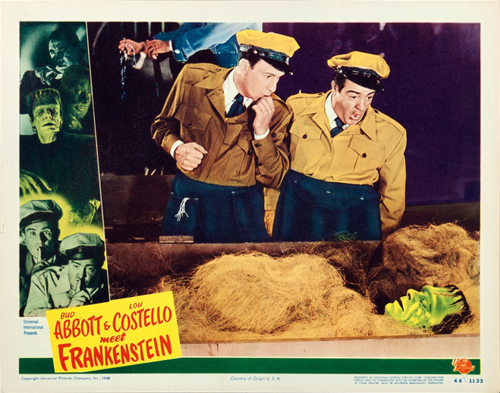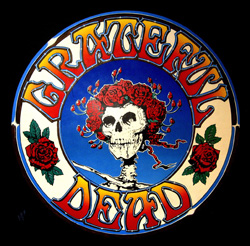
Your complimentary articles
You’ve read one of your four complimentary articles for this month.
You can read four articles free per month. To have complete access to the thousands of philosophy articles on this site, please
Films
Abbott & Costello Meet Frankenstein
David White takes a long strange trip with Jerry Garcia to watch Abbott and Costello meet Frankenstein.
Years after writing Frankenstein, Mary Shelley published her Rambles in Germany and Italy in 1840, 1842, and 1843. Early on in it she states her therapeutic intent:
“Travelling will cure all: my busy, brooding thoughts will be scattered abroad; and, to use a figure of speech, my mind will, amidst novel and various scenes, renew the outworn and tattered garments in which it has long been clothed, and array itself in a vesture all gay in fresh and glossy hues, when we are beyond the Alps.”
(Part I, Letter I, p.2)
Even if the classic 1948 comedy Abbott and Costello Meet Frankenstein deviates from Mary Shelley’s novel too much, it is spot-on regarding her larger project of how best to navigate in the pilgrimage of life. By pilgrimage here I mean not a predetermined track, but rather just the opposite, since what is most abhorrent is to let someone else determine your proper path, instead of having a keyed-up watchfulness for the full range of possible futures.

Film poster © Universal Studios 1948
In Mary Shelley’s famous story, pioneering scientist Victor Frankenstein’s project concerns “the nature of the principle of life, and whether there was any probability of its ever being discovered and communicated.” Shelley’s own project in writing the book was to establish herself as a woman fully capable of dealing with such a serious subject. What then was the project of the Abbott and Costello film?
The first twenty-five minutes of the film consists of a debate between baggage handlers Chick (Bud Abbott) and Wilbur (Lou Costello) as they wrestle with a most unusual consignment of crates addressed to a ‘house of horrors’. Chick pours derision on what Wilbur thinks he has just experienced (namely, seeing the Frankenstein monster, Dracula, and the Wolfman moving around). The parallels with whether the Bible is true or only a fiction are too obvious to be argued, but Wilbur’s main point, stated several times in different words, is that whether fact or illusion, his personal experiences are sufficient to scare him to the point of being paralyzed with fear. That frozen-speechless state is presented in the film as unquestionably real, or at least real enough for the movie audience to have an empathic reaction. That audience reaction is just as real even for those who keep reminding themselves that what they are watching is only a movie. By the end of the film Chick is persuaded that he should believe and trust Wilbur’s testimony, especially when they both ‘see’ the Invisible Man.
The deeper truth here is that a fiction believed can be efficacious, even more efficacious than fact, depending on the character and skills of those who believe or disbelieve. Chick and Wilbur’s project in the film is simply to do their job as baggage handlers, just as Bud Abbott and Lou Costello’s job was to entertain the cinema audience. (Given the box office success of the film, which revitalized their careers, they most certainly did).
Interestingly enough, rock legends The Grateful Dead were greatly influenced by Abbott and Costello’s meeting with Frankenstein. Jerry Garcia began an interview by making the point at some length that he was first taken to the Abbott and Costello film by his mother at age eight with no idea of what he was getting into and was scared by what he saw. He mentions the various postures of physical fear. (Google “Jerry Garcia Meets Frankenstein” for several clips.) He discusses the film’s effect on his creative life in other places too. What are we to make of the real power of a fiction?
Memo to my fellow philosophers: I’ve no intention here of disparaging our tradition of presenting with utmost clarity a list of propositions and determining with professional rigor the cogency of the inferences from premises to conclusions. My hope rather is to expand our awareness to include other goings-on, conscious and unconscious, using art to recognize, categorize, alter and illuminate what is in fact happening whether we acknowledge it or not. Whether classified as art, science, craft, leaps of imagination, tales of the strange, dream sequences, or streams of consciousness, fact or fiction, terrifying, satisfying, therapeutic, mystifying or sanctifying, or filed under ‘whimsy,’ there is something for everyone in this mansion with its many rooms with extensions and expansions added daily. Or perhaps instead of mansion, one should say ‘Frankenstein’s Laboratory’.
But how can philosophers work with anything as notoriously changeable and insubstantial as the contents of imagination? How is anything checkable or comparable or verifiable or falsifiable? Even or especially if the backbone of argumentation is lucid and irresistibly valid, the flesh clinging to the bone and the garments draped over the flesh are mutable if not ephemeral, and the whole scene can be manipulated, redecorated, filtered, seen through a lens, or under the influence of substances, controlled or uncontrolled.
The lectures of Dr Horatio Prater (1806-1885) on the then-fashionable subject of hypnotism, surprisingly contain what looks a little like an early version of Ludwig Wittgenstein’s much later argument against the possibility of a private language:
“Bishop Butler, in his work, has insisted much on what we appear to see in dreams, in evidence of the soul having the power to see, without the use of the bodily organs, the eyes. But, in reality, as the things are not there which appear to be seen, this only proves that a certain degree of activity may exist in the soul when all the senses are, as nearly as possible, in a state resembling death. Without the corrections from the senses, the soul, however, would appear to have no power of forming correct ideas of external nature. The seeing in sleep is an illusion produced by the vast increase of the imagination, aided by memory.” (Lectures on true and false Hypnotism, or Mesmerism. London: Piper Brothers, 1851, p.78.)
Prater is of course right that without a public system of correction we have no way of determining if our ideas are correct. What Prater and so many others have missed is that the whole realm of imagination, while distinct from physical reality, has a correction system of its own. That system concerns itself as much and as legitimately with the effect of ideas as our checking system for the physical world concerns the origin of ideas in physical reality. Ideas presented in imagination are still judged by their associations with other ideas and effects upon those ideas. If we are reluctant to dismiss a work of fiction as false, we certainly do not hesitate to call some fictions wrong or useless or ineffective, all of which are terms of correction. For example: Sherlock Holmes and Watson are fictional characters, and in the original sixty stories, Watson has an interest in romance and Holmes doesn’t. In later adaptations, Holmes becomes romantically involved with Irene Adler, also a fictional being. Some fans, critics, and audiences are strongly put off by Holmes’ involvement with any woman. Obviously, the distress they feel has nothing to do with what is true or false in real life, but rather with what seems or feels fitting or right for the character that has been created in the original stories. There is no phenomenological difference between God coming to me in a dream and my dreaming that God came to me, but in both cases we can argue the rights and wrongs of the claims made.
Those who see the business of life as the search for truth will expend equal energy in studying the pure phenomena independent of alleged cause and effect, the scientifically discovered origins or explanation of the phenomena, and the socially significant consequences of the phenomena regardless of its genesis, and will understand that even if these three investigations leave us able to interpret the world, the point remains that of changing it.

Garcia is commendably specific regarding the ways the film changed him, including the dignity of the monsters; a fascination with the drive to reanimate, with movies and film making, with drawing the monster. He talks of the power of fear and of comedy as a smart strategy in life to get by, disarming the powerful. Garcia’s longest discourse on Abbott and Costello Meet Frankenstein is in the AMC program The Movie That Changed My Life, from which excerpts are used in the Long Strange Trip series. “I have a general fascination with the bizarre that comes directly from that movie,” Garcia says. “That was my first sense of, there are things in this world that are really weird. I don’t think I knew that before I saw that movie. There are things that are really weird and there are people who are concerned with them. That some way, that became important to me and I guess I thought to myself on some level: I think I want to be concerned with things that are weird, I think that seems interesting to me because that seems like fun … and that is in fact, who I am.”
Garcia’s philosophy of consciousness expansion (dilation), is more than drug induced or drug involved. Don’t plan, don’t think, don’t worry, stay alert for the next thing, do your own thing, don’t forget to take your dose of crazy, all this derives from the Abbott & Costello film, which itself would be impossible without the Universal monsters, monsters of which Frankenstein’s (Mary’s) is one of the best known and most effective. To quote from that seminal film:
Chick Young: [reading exhibit card] “Frankenstein gave the Monster eternal life by shooting it full of electricity. Some people claim it is not dead even now, just dormant.”
[laughs to Wilbur]
Chick Young: Now, who would be silly enough to believe that?
[laughs more]
Wilbur Grey: [joins in laughter] Who would be silly enough to believe that?
[more laughter as he beckons Chick closer, then says, worried]
Wilbur Grey: … Me!
The origins of Frankenstein as a text lie in Mary Shelley’s desires to participate in a storytelling contest with her friends and to provoke a discussion of the promising but potentially dangerous ideas associated with vitalization. The results of her effort would now fill an entire library and continue to grow. This article concerns some aspects of just one line in the vast genealogy of Frankenstein. Mary Shelley, Abbott and Costello, and Jerry Garcia worked on the Frankenstein story, drawing primarily on their imaginations. It was the richness, one might say genius, of their imaginations that earned them enduring fame. My intent in following this one ripple in the stream of consciousness is to eliminate the speculative altogether and focus instead entirely on the factual. I leave the reader free to decide for himself or herself whether the apparent healing and the alleged liberation provided by such imaginative rambling are indicative of anything worth pursuing in their own lives. There are certainly plenty of paths to wander, in the byways of ideas, in film and in music too.
© David E. White 2018
David White is Professor Emeritus of Philosophy at St John Fisher College and Chair of the Bishop Butler Society Ltd, bishopbutler.org.








